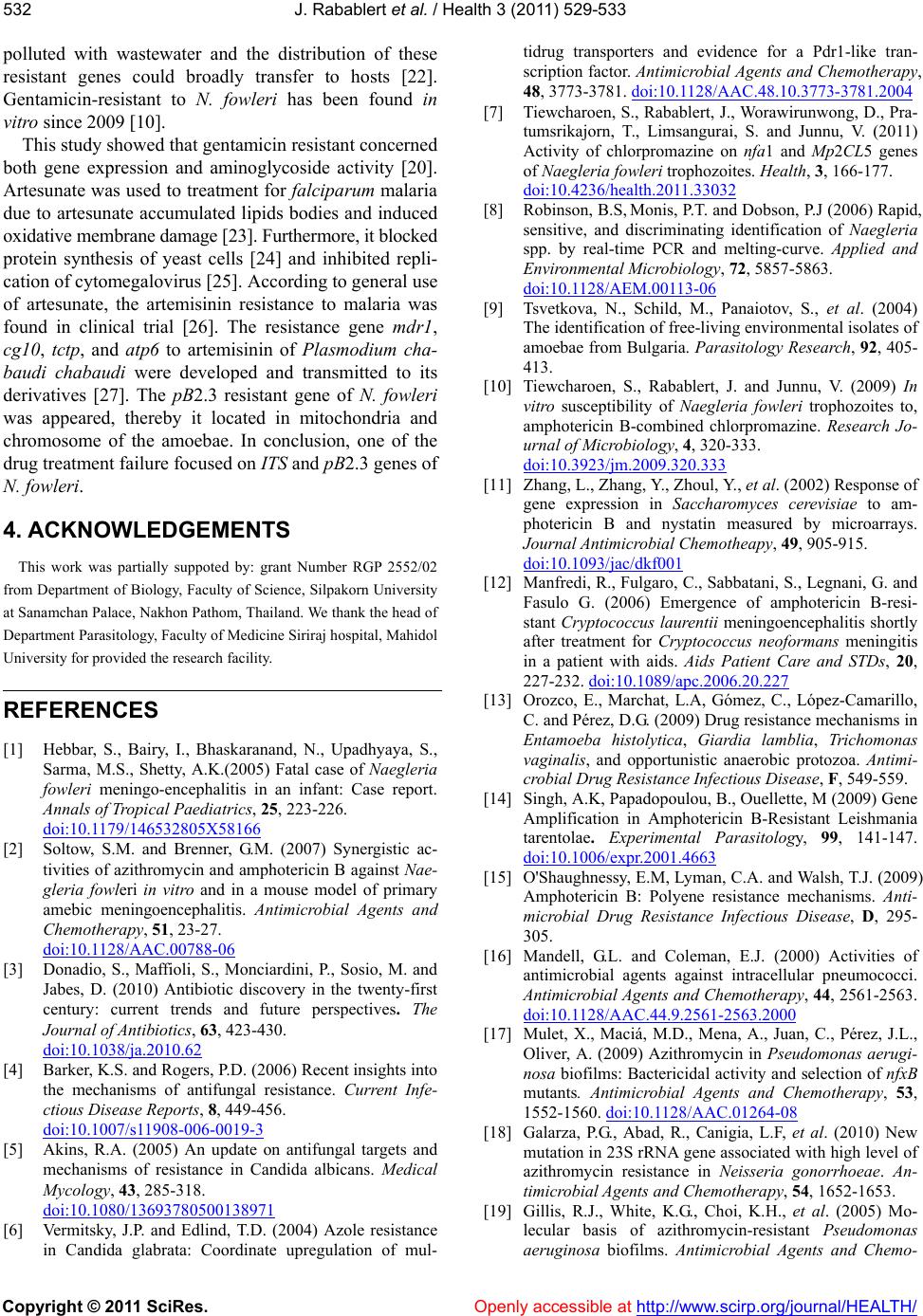
J. Rabablert et al. / Health 3 (2011) 529-533
Copyright © 2011 SciRes. Openly accessible at http:// www.scirp.org/journal/HEALTH/
532
polluted with wastewater and the distribution of these
resistant genes could broadly transfer to hosts [22].
Gentamicin-resistant to N. fowleri has been found in
vitro since 2009 [10].
This study showed that gentamicin resistant concerned
both gene expression and aminoglycoside activity [20].
Artesunate was used to treatment for falciparum malaria
due to artesunate accumulated lipids bodies and induced
oxidative membrane damage [23]. Furthermore, it blocked
protein synthesis of yeast cells [24] and inhibited repli-
cation of cytomegalovirus [25]. According to general use
of artesunate, the artemisinin resistance to malaria was
found in clinical trial [26]. The resistance gene mdr1,
cg10, tctp, and atp6 to artemisinin of Plasmodium cha-
baudi chabaudi were developed and transmitted to its
derivatives [27]. The pB2.3 resistant gene of N. fowleri
was appeared, thereby it located in mitochondria and
chromosome of the amoebae. In conclusion, one of the
drug treatment failure focused on ITS and pB2.3 genes of
N. fowleri.
4. ACKNOWLEDGEMENTS
This work was partially suppoted by: grant Number RGP 2552/02
from Department of Biology, Faculty of Science, Silpakorn University
at Sanamchan Palace, Nakhon Pathom, Thailand. We thank the head of
Department Parasitology, Faculty of Medicine Siriraj hospital, Mahidol
University for provided the research facility.
REFERENCES
[1] Hebbar, S., Bairy, I., Bhaskaranand, N., Upadhyaya, S.,
Sarma, M.S., Shetty, A.K.(2005) Fatal case of Naegleria
fowleri meningo-encephalitis in an infant: Case report.
Annals of Tropical Paediatrics, 25, 223-226.
doi:10.1179/146532805X58166
[2] Soltow, S.M. and Brenner, G.M. (2007) Synergistic ac-
tivities of azithromycin and amphotericin B against Nae-
gleria fowleri in vitro and in a mouse model of primary
amebic meningoencephalitis. Antimicrobial Agents and
Chemotherapy, 51, 23-27.
doi:10.1128/AAC.00788-06
[3] Donadio, S., Maffioli, S., Monciardini, P., Sosio, M. and
Jabes, D. (2010) Antibiotic discovery in the twenty-first
century: current trends and future perspectives. The
Journal of Antibiotics, 63, 423-430.
doi:10.1038/ja.2010.62
[4] Barker, K.S. and Rogers, P.D. (2006) Recent insights into
the mechanisms of antifungal resistance. Current Infe-
ctious Disease Reports, 8, 449-456.
doi:10.1007/s11908-006-0019-3
[5] Akins, R.A. (2005) An update on antifungal targets and
mechanisms of resistance in Candida albicans. Medical
Mycology, 43, 285-318.
doi:10.1080/13693780500138971
[6] Vermitsky, J.P. and Edlind, T.D. (2004) Azole resistance
in Candida glabrata: Coordinate upregulation of mul-
tidrug transporters and evidence for a Pdr1-like tran-
scription factor. Antimicrobial Agents and Chemotherapy,
48, 3773-3781. doi:10.1128/AAC.48.10.3773-3781.2004
[7] Tiewcharoen, S., Rabablert, J., Worawirunwong, D., Pra-
tumsrikajorn, T., Limsangurai, S. and Junnu, V. (2011)
Activity of chlorpromazine on nfa1 and Mp2CL5 genes
of Naegleria fowleri trophozoites. Health, 3, 166-177.
doi:10.4236/health.2011.33032
[8] Robinson, B.S, Monis, P.T. and Dobson, P.J (2006) Rapid,
sensitive, and discriminating identification of Naegle ri a
spp. by real-time PCR and melting-curve. Applied and
Environmental Microbiology, 72, 5857-5863.
doi:10.1128/AEM.00113-06
[9] Tsvetkova, N., Schild, M., Panaiotov, S., et al. (2004)
The identification of free-living environmental isolates of
amoebae from Bulgaria. Parasitology Research, 92, 405-
413.
[10] Tiewcharoen, S., Rabablert, J. and Junnu, V. (2009) In
vitro susceptibility of Naegleria fowleri trophozoites to,
amphotericin B-combined chlorpromazine. Research Jo-
urnal of Microbiology, 4, 320-333.
doi:10.3923/jm.2009.320.333
[11] Zhang, L., Zhang, Y., Zhoul, Y., et al. (2002) Response of
gene expression in Saccharomyces cerevisiae to am-
photericin B and nystatin measured by microarrays.
Journal Antimicrobial Chemotheapy, 49, 905-915.
doi:10.1093/jac/dkf001
[12] Manfredi, R., Fulgaro, C., Sabbatani, S., Legnani, G. and
Fasulo G. (2006) Emergence of amphotericin B-resi-
stant Cryptococcus laurentii meningoencephalitis shortly
after treatment for Cryptococcus neoformans meningitis
in a patient with aids. Aids Patient Care and STDs, 20,
227-232. doi:10.1089/apc.2006.20.227
[13] Orozco, E., Marchat, L.A, Gómez, C., López-Camarillo,
C. and Pérez, D.G. (2009) Drug resistance mechanisms in
Entamoeba histolytica, Giardia lamblia, Trichomonas
vaginalis, and opportunistic anaerobic protozoa. Antimi-
crobial Drug Resistance Infectious Disease, F, 549-559.
[14] Singh, A.K, Papadopoulou, B., Ouellette, M (2009) Gene
Amplification in Amphotericin B-Resistant Leishmania
tarentolae. Experimental Parasitology, 99, 141-147.
doi:10.1006/expr.2001.4663
[15] O'Shaughnessy, E.M, Lyman, C.A. and Walsh, T.J. (2009)
Amphotericin B: Polyene resistance mechanisms. Anti-
microbial Drug Resistance Infectious Disease, D, 295-
305.
[16] Mandell, G.L. and Coleman, E.J. (2000) Activities of
antimicrobial agents against intracellular pneumococci.
Antimicrobial Agents and Chemotherapy, 44, 2561-2563.
doi:10.1128/AAC.44.9.2561-2563.2000
[17] Mulet, X., Maciá, M.D., Mena, A., Juan, C., Pérez, J.L.,
Oliver, A. (2009) Azithromycin in Pseudomonas aerugi-
nosa biofilms: Bactericidal activity and selection of nfxB
mutants. Antimicrobial Agents and Chemotherapy, 53,
1552-1560. doi:10.1128/AAC.01264-08
[18] Galarza, P.G., Abad, R., Canigia, L.F, et al. (2010) New
mutation in 23S rRNA gene associated with high level of
azithromycin resistance in Neisseria gonorrhoeae. An-
timicrobial Agents and Chemotherapy, 54, 1652-1653.
[19] Gillis, R.J., White, K.G., Choi, K.H., et al. (2005) Mo-
lecular basis of azithromycin-resistant Pseudomonas
aeruginosa biofilms. Antimicrobial Agents and Chemo-